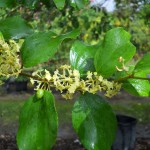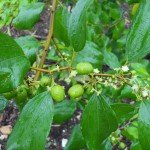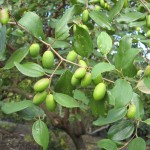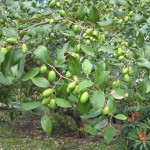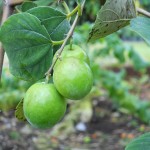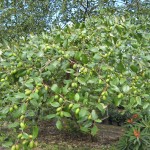Jujube Tree (Zizyphus jujuba)
The Jujube tree is a fruit tree in the Rhamnaceae, or Buckthorn Family, that grows very well in southern Florida. Its origin is southern Asia and for 4,000 years it has been cultivated in China, where there are 400 known varieties. It can attain a height of 20 ft. and a width of 12 ft., and features shiny green foliage. It bears a small oval fruit from late November through January. The fruit, eaten fresh while still smooth and green, has the consistency and taste of an apple. It later matures to a purplish-black coloration. It is at this stage that the fruits are dried and become chewy, with a date-like consistency, giving them the common name Red Dates. This species is extremely cold tolerant, surviving temperatures down to about 5º F.
In China, its products include jujube tea, as well as juice and a vinegar used to make pickles. A wine is also made from the fruit. Chinese medicine uses the fruit to kill internal parasites, promote liver function, and improve the pulmonary system. In Iranian cuisine, the dried fruits are eaten as a snack.
Jujubes were first introduced into the United States in the late 1800s, but quickly fell out of favor due to the fact that the variety introduced was best suited for drying and not eaten fresh. It wasn’t until the 1990s that growers introduced a variety cultivated for eating fresh off the tree. Most recently, in 2007, two more varieties were introduced for fresh fruit. It seems unclear which cultivars are being sold in the nursery trade today; however, it is known that the following named cultivars are the best for eating fresh: ‘Sugar Cane’, ‘Li’, ‘Sherwood’, ‘Chico’, and ‘Honey Jar’. Of those, ‘Honey Jar’ is the smallest and juiciest. ‘Lang’ and ‘Shanxi Li’ are best for drying and eating like dates. One thing is clear, though: Each tiny fruit has 20 times more vitamin C than does citrus.
Richard Lyons’ Nursery sells fresh jujube fruit in season, as well as trees in 3-gal. and 7-gal. containers.
